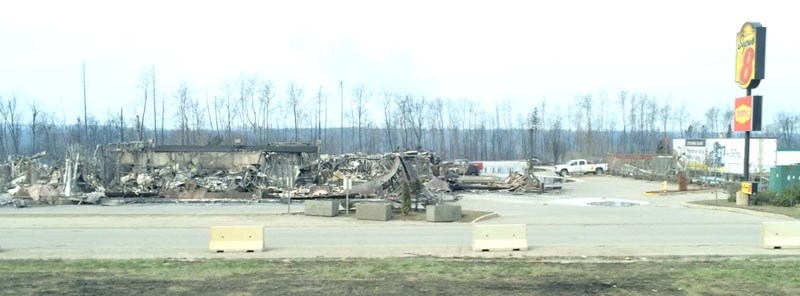Brian Simpson had an important decision to make last Wednesday night: drive into the still-burning Fort McMurray, or turn around and take the vital load of food in his semi-truck back home.
Brian Simpson had an important decision to make last Wednesday night: drive into the still-burning Fort McMurray, or turn around and take the vital load of food in his semi-truck back home.
He and his driver, John, were some of the only non-emergency personnel that had been let past the RCMP roadblock south of town, and were on a mission to resupply the work camps to the north that had been swamped by evacuees earlier that day. They could see fires flaring up on either side of the highway, and one structure near the airport was clearly ablaze.
“So I said to the guy I was with, ‘How fast can we dump a trailer?'” Simpson said, with a chuckle.
After figuring out that the fire probably wasn't right next to the road itself, Simpson made the call to drive on, planning to ditch the truck's load and run if he was wrong.
That made him one of the first St. Albert civilians to get an up close look at the state of the city.
Simpson, a cabinet maker, had been asked by his wife, Carolyn Peters, to act as a scout for the lead truck in a 35-vehicle convoy to Fort McMurray last week.
Peters worked for TJ Zaychuk Trucking, one of the main suppliers of food to the work camps around Fort McMurray, and had seen the news about the fires up north last Tuesday.
“We knew something was going to go down,” she said.
Camp operators flooded her office with calls for food and water the next day, and staff quickly assembled the convoy. Needing someone who could report back on field conditions, she texted Simpson at about 6:30 p.m. Wednesday and asked if he could leave immediately. Simpson said he met up with John just moments before he was about to set off.
The city itself was visible as an ominous sunrise from 75 kilometres away, Simpson's photos show. The RCMP waived their convoy through at the checkpoint, as they had a sign indicating that they were essential services, telling them to stay in the middle of the road as the fire was burning on both sides of it, and to proceed at their own risk.
It was pitch black at the south side of town where the Super 8 Motel burned down, Simpson said – the only light was from their headlights and the fire itself. The sides of the highway glowed with what seemed like hundreds of campfires. They could see only 20 feet ahead in spots due to the thick smoke, which burned at his eyes and made him wish he'd brought his respirator.
Passing through downtown (which still had electricity) was a little eerie, he continued.
“There's not one vehicle anywhere,” he said, and with the exception of one garage, nothing had burned down. There wasn't even any smoke. He credited firefighters for working “crazy hard” for keeping this region safe.
Heading over the Athabasca River, Simpson said he could see 50- to 100-foot flames roaring through the trees near the Thickwood region to the west.
He and John took their semi-load of supplies to about five different camps north of the city at about 2 a.m. Thursday.
“When we got to the camps, everyone was running up to us asking us questions,” he said, often asking if the road was back open. One old man asked them if he could get a ride south and asked about the state of his home. (Simpson told them that it looked intact, so far as he could tell.)
The camps were almost completely out of food when they arrived, Simpson said. The first one they visited, Barge, was actually evacuated soon after they left it.
Heading home later that day gave them a better look at the state of the city.
“It's like a war zone,” Simpson said.
Stranded vehicles littered the ditches, the grass in which was often scorched black to within a foot of the highway. While some vehicles and structures had been reduced to ash and rubble, many others were completely intact. There were even three trailers that seemed completely untouched in an otherwise incinerated RV park.
“I'm just amazed that everyone got out,” Simpson said.
The fire itself covered about 2,040 square kilometres as of Monday, provincial officials reported – that's roughly the size of Sturgeon County. Plans to bring residents back into Fort McMurray are expected within two weeks.
Although some 2,400 structures had been lost, some 25,000 had been saved, including the hospital, municipal buildings, and schools, Premier Rachel Notley told reporters Monday. Some 90 per cent of the city was still intact.
Simpson predicted that the city would be rebuilt much more quickly than Slave Lake after the 2011 fire as most of this city's infrastructure was still intact.
“It's going to be real unfortunate for a lot of people,” he added.
